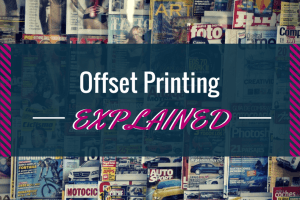What is offset printing? Why would you choose Offset over Digital Printing? Hopefully our explanation below will shed some light!
Offset lithography printing is one of the most common ways of creating printed materials and is a process used by both web (whereby printing is carried out on a single, continuous sheet of paper fed from a large roll and then cut into individual sheets of desired sizes) and sheet-fed (the printing is carried out on single sheets of paper as they are fed to the press one at a time) printing machines. The technology is radically different to that of digital printing presses, an explanation of which will follow in a future blog.
Offset printing is typically the most cost effective printing solution for producing large volumes of high quality print. Magazine and Catalogue printing typically use this process as well as other mediums listed below:-
- newspapers
- brochures
- books
The technical bit…..printing the ink onto the paper
All up to date offset printing plants have a pre-press studio that utilises a computer-to-plate system that outputs the image from the artwork directly onto aluminium printing plates. These printing plates are imaged using a laser which burns the image directly onto the specially treated plates.
Offset lithography works on one basic principle: water and oil-based ink don’t mix. Using this theory, as the plate passes through the press it runs through ink and water rollers. The image area (design and words) of the plate attracts the ink from the ink rollers and water to the non-image area.
The inked image on each plate is then transferred onto a rubber cylinder (called a blanket) which in turn transfers the image onto the paper. As the printing plate has no direct contact with the paper it is ‘offset’ – thus the term “offset” lithography.
It also prolongs the life of the plates and what’s more, the rubber is flexible and conforms willingly to the print surface, which allows the process to work well on non-smooth surfaces such as newsprint paper.
Colours
A typical print job is printed using the 4 process colours CYMK: Cyan (blue), Yellow, Magenta and Black. Small dots of the four inks are placed in precise patterns that convince our eyes that we are in fact looking at a wide range of colours. It is for this reason that offset printing is often referred to as 4-colour process or 4-colour printing.
Some of our suppliers (both sheet-fed and web) have equipment that has additional printing units so that they can print premixed additional special colours such as Gold and Silver or fluorescents for customers requiring extra colour options. This is referred to as ‘spot colours’ and allows a breadth of differing colours outside the usual colour range.
Each colour requires its own plate and in the case of modern web offset (or perfecting printing presses), each side of the paper sheet also requires a plate, so that the paper is printed on both sides of the sheet at the same time.
The last stages….
With all that ink and water being applied, the paper is naturally slightly wet and runs a risk of smudging. So, to counter this issue, the web presses pass the paper through a gas fired oven which runs at 350 to 400 degrees Fahrenheit (or 176 to 206 degrees Celsius).
Sheet-fed presses differ in this instance as they use oxidising inks so the paper is air-dried. The reason behind this difference is that web-presses require a quicker drying process because the paper is folded in section inline ready for binding. Sheet fed presses are folded off-line and can afford the additional drying time.
Advantages of Offset Printing
- Consistent Image Quality: Vivid, precise colours with clear typefaces and fine detailed photographs.
- Variety of Print runs: This process is ideal for small, medium or high-volume jobs.
- Economies of scale: The more you print, the less you pay per item. As most of the cost is in the setup) and extra quantities have a nominal cost per sheet for the paper and ink.
Key points
- Uses imaged aluminium plates
- Typical printing process would be (cyan C yellow Y magenta M black K)
- Process is common across both web and sheet fed printing presses
- Printing either fifth or sixth colours is common on sheet-fed presses and on some web offset machines.
- Prints on paper ranging from Newsprint to triple coated Gloss and most grades in between.
- Sheet fed printing typically from 1000 copies with Web-offset printing from 5000 copies.
- Machine dependant, printing can be on paper as light as 39gsm or as heavy as 1000 micron.
For free advice about your printing projects or to ask for a quote please email [email protected] or call us on 01323 419701
